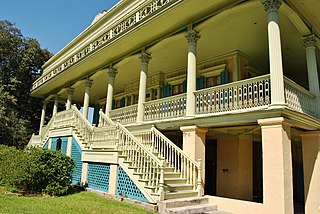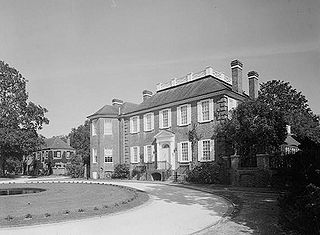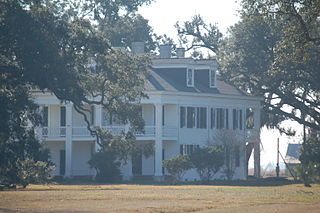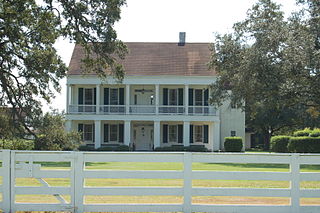
St. John the Baptist Parish is a parish located in the U.S. state of Louisiana. At the 2020 census, the population was 42,477. The parish seat is Edgard, an unincorporated area, and the largest city is LaPlace, which is also unincorporated.

Natchitoches, officially the City of Natchitoches, is a small city and the parish seat of Natchitoches Parish, Louisiana, United States. At the 2020 United States Census, the city's population was 18,039. Established in 1714 by Louis Juchereau de St. Denis as part of French Louisiana, the community was named after the indigenous Natchitoches people.

Shirley Plantation is an estate on the north bank of the James River in Charles City County, Virginia. It is located on scenic byway State Route 5, between Richmond and Williamsburg. It is the oldest active plantation in Virginia and the oldest family-owned business in North America, dating back to 1614, with operations starting in 1648. It used about 70 to 90 African slaves at a time for plowing the fields, cleaning, childcare, and cooking. It was added to the National Register in 1969 and declared a National Historic Landmark in 1970. After the acquisition, rebranding, and merger of Tuttle Farm in Dover, New Hampshire, Shirley Plantation received the title of the oldest business continuously operating in the United States.

Oak Alley Plantation is a historic plantation located on the west bank of the Mississippi River, in the community of Vacherie, St. James Parish, Louisiana, U.S. Oak Alley is named for its distinguishing visual feature, an alley or canopied path, created by a double row of southern live oak trees about 800 feet long, planted in the early 18th century — long before the present house was built. The allée or tree avenue runs between the home and the River. The property was designated a National Historic Landmark for its architecture and landscaping, and for the agricultural innovation of grafting pecan trees, performed there in 1846–47 by a gardener.

The Parlange Plantation House is a historic plantation house at Louisiana Highway 1 and Louisiana Highway 78 in Pointe Coupee Parish, Louisiana. Built in 1750, it is a classic example of a large French Colonial plantation house in the United States. Exemplifying the style of the semi-tropical Louisiana river country house, the Parlange Plantation home is a two-story raised cottage. The main floor is set on a brick basement with brick pillars to support the veranda of the second story. The raised basement is of brick, manufactured by enslaved people on the plantation. The walls, both inside and out, were plastered with a native mixture of mud, sand, Spanish moss and animal hair (bousillage), then painted. The ground story and second floors contain seven service rooms, arranged in a double line. The walls and ceiling throughout the house were constructed of close-fitting bald cypress planks.

The Metlar House, also known as the Knapp House, the Bodine House, or the Metlar–Bodine House, is an historic house, now museum, located along River Road in Piscataway, New Jersey. It is also believed to be haunted. In 2003 a fire badly damaged the house. The museum has undergone major renovations over the past decade and, as of Summer 2014, is once again open to the public.

Riverlake is a plantation and an antebellum mansion, located on the west bank of the False River in Pointe Coupee Parish, Louisiana, about 8 miles (13 km) south of New Roads, Louisiana.

Laura Plantation is a restored historic Louisiana Creole plantation on the west bank of the Mississippi River near Vacherie, Louisiana, (U.S.), open for guided tours. Formerly known as Duparc Plantation, it is significant for its early 19th-century Créole-style raised big house and several surviving outbuildings, including two slave cabins. It is one of only 15 plantation complexes in Louisiana with this many complete structures. Because of its historical importance, the plantation is on the National Register of Historic Places. The site, in St. James Parish, Louisiana, is also included on the Louisiana African American Heritage Trail.

Rosedown Plantation State Historic Site is an 8,000-square-foot (740 m2) historic home and former plantation located in St. Francisville, Louisiana, United States. Built in 1835 by Daniel and Martha Turnbull, it is one of the most documented and intact plantation complexes in the Southern United States. It is known for its extensive formal gardens surrounding the house.

Evergreen Plantation is a plantation located on the west side of the Mississippi River in St. John the Baptist Parish, near Wallace, Louisiana, and along Louisiana Highway 18. The main house was constructed mostly in 1790, and renovated to its current Greek Revival style in 1832. The plantation's historical commodity crop was sugarcane, cultivated by enslaved African Americans until emancipation.

Oakland Plantation, originally known as the Jean Pierre Emmanuel Prud'homme Plantation, and also known as Bermuda, is a historic plantation in and unincorporated area of Natchitoches Parish, Louisiana. Founded as a forced-labor farm worked by enslaved Black people for White owners, it is one of the nation's best and most intact examples of a French Creole cotton plantation complex. The Oakland Plantation is now owned by the National Park Service as part of the Cane River Creole National Historical Park.

The Edward Douglass White House, also known as Edward Douglass White Louisiana State Commemorative Area, is a state historic site near Thibodaux, Louisiana. The house was home to both Edward Douglass White, Sr., the tenth governor of the state of Louisiana, and his son, Edward Douglass White, a U.S. senator and a Chief Justice of the United States. It was designated a National Historic Landmark in 1976 for its association with the latter White, who was in the 7-1 majority ruling on Plessy v. Ferguson, 163 U.S. 537 (1896), a landmark decision of the U.S. Supreme Court that upheld the constitutionality of racial segregation laws for public facilities in a doctrine that came to be known as "separate but equal."

The Whitney Plantation Historic District is preserved by the Whitney Institute, a non-profit whose mission is to educate the public about the history and legacies of slavery in the Southern United States. The district, including the main house and outbuildings, is preserved near Wallace, in St. John the Baptist Parish, Louisiana, on the River Road along the Mississippi River. Habitation Haydel was founded in 1752 by Ambroise Heidal, one of the many German immigrants who colonized the river parishes in the 18th century. His descendants owned it until 1860. In 1867 it was sold to businessman Bradish Johnson who renamed it Whitney.

The Fenwick Hall, which is also known as Fenwick Castle, is a plantation house built about 1730 on Johns Island, South Carolina, across the Stono River from James Island and Charleston. It is located between River Road and Penneys Creek. It was named to the National Register of Historic Places on February 23, 1972.

Ashland Plantation, also known as the Belle Helene or Ashland-Belle Helene Plantation, is a historic building, built in 1841, that was a plantation estate and home of Duncan Farrar Kenner. Located in Darrow, Louisiana, in Ascension Parish. The manor house is an example of antebellum Greek Revival architecture.

Rienzi Plantation House is a historic mansion located at 215 East Bayou Road in Thibodaux, Louisiana.

The Houmas, also known as Burnside Plantation and currently known as Houmas House Plantation and Gardens, is a historic plantation complex and house museum in Burnside, Louisiana. The plantation was established in the late 1700s, with the current main house completed in 1840. It was named after the native Houma people, who originally occupied this area of Louisiana.

Felicity Plantation is a historic sugarcane plantation on the banks of the Mississippi River in the U.S. state of Louisiana. It is located along Louisiana Highway 18 in Vacherie, St. James Parish. Felicity is a sister plantation to St. Joseph Plantation, and was built around 1846 by Valcour Aime as a wedding gift to his daughter, Felicite Emma, and her spouse, Septime Fortier, who was also her cousin. Acquired by a bank in 1873, the plantation was purchased by Saturnine Waguespack in 1890, who merged it with the St. Joseph Plantation to form the St. Joseph Plantation and Manufacturing Company. The house still remains in the Waguespack family.

Bocage Plantation is a historic plantation in Darrow, Ascension Parish, Louisiana, about 25 miles (40 km) southeast of Baton Rouge. The plantation house was constructed in 1837 in Greek Revival style with Creole influences, especially in the floorplan. Established in 1801, the plantation was added to the National Register of Historic Places on June 20, 1991.

Mulberry Grove is a historic mansion in Donaldsonville, Louisiana, U.S.. It was designed in the Greek Revival architectural style, and it was built in 1836 for Dr Duffel.






















